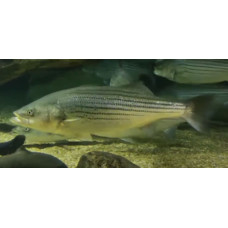Latin name
Morone saxatilis
Other names
Striper, rock, rockfish, striped sea bass, striper bass, linesider, squid hound, and greenhead; French: bar rayé; Spanish: lubina estriada.
Identification
A large fish with a large mouth. The striped bass is more streamlined than its close relative, the white bass. It has a long body and long head, a somewhat laterally compressed body shape, and a protruding lower jaw. Of the two markedly separated dorsal fins, the first has from 7 to 12 rigid spines, usually 9, making this fin slightly taller than the second. The second dorsal fin has one sharp spike and 8 to 14, typically 12, soft rays. It has a forked tail and small eyes. These fish are mostly bluish-black or dark green on top, transitioning to silver on the sides and white on the belly. The striped bass has seven or eight prominent black horizontal stripes running along the rows of scales on each side of its body, which are its distinguishing features. One of the stripes runs along the lateral line, and the others are equally divided above and below it. The uppermost stripe on the side is usually the most prominent, with some fish having one or more stripes interrupted.
Distribution
On the Atlantic coast of the United States, striped bass are commonly found from the St. Lawrence River south to the St. Johns River in northern Florida. It is also found along the coast of Florida, Louisiana, Alabama, and Mississippi in the Gulf of Mexico. Some fish migrate north from North Carolina, Virginia, or Maryland during the summer and return in the fall. Others, found in estuaries of river systems such as the St. Lawrence River, Santee Cooper, or Savannah River, are not migratory. Striped bass were introduced into San Francisco Bay in 1879 and 1882. Today it is abundant on the Pacific Coast. Some California fish migrate north to Oregon and are sometimes found off the west coast of Vancouver Island. Striped bass are state fish of the states of Maryland, Rhode Island, and South Carolina, and state saltwater fish of New York, New Jersey, Virginia, and New Hampshire.
Habitat
Striped bass live in salt, brackish, and fresh water. They are anadromous and migrate through coastal inland waters and tides. They are often found near piers, jetties, reefs, flats, rocks. The common name is "rockfish," and the scientific name is "saxatilis" meaning "rock dweller," although they do not always spend most of their lives near rocks. They go far upstream during spawning, and at this time they can also be found in the channels of medium and large rivers. Striped bass are an entirely coastal species, living off the coast of the Caroline Islands and further south, never moving more than a few miles from shore. Striped bass have been introduced into freshwater lakes and reservoirs with successful results. In freshwater, striped bass usually inhabit open water bodies.
Size
They grow rapidly at an early age, averaging 5 to 10 pounds, often reaching 30 to 50 pounds. The maximum size is unknown, although the largest freshwater striped bass caught in sport weighed 67 pounds, 1 ounce. Striped bass usually live 10 to 12 years.
Life history and Behavior
Male striped bass become sexually mature in their second or third year of life, females between about the eighth and ninth years of life. Males spawn at least 7 inches and females up to 34 inches. Spawning occurs in fresh or slightly brackish waters from mid-February in Florida, to late June or July in Canada, to mid-March to late July in California. Water temperature for spawning should be between 50° and 73°F; peak activity occurs between 54° and 68°F. Prefer the mouths of freshwater tributaries where the current is strong enough to keep the eggs suspended. Several smaller males accompany the female during mating. Spawning fish swim near the surface of the water, flipping on their sides, rolling over, and splashing around. The semi-mobile eggs are released and drift with the current until they hatch in 2-3 days, depending on water temperature.
Food and feeding habits
A voracious, carnivorous predator. It feeds on small fish, including large numbers of herring, menhaden, flounder, silverside, eel, and smelt, as well as invertebrates such as worms, squid, and crabs. Freshwater striped bass choose to shad, herring, minnows, May flies.
Reproduction
No information
| Classification | |
| Phylum | Chordata |
| Class | Actinopterygii |
| Family | Moronidae |
| Genus | Morone |
| Species | M. saxatilis |
| Features | |
| Conservation status | Least Concern |
| Habitat | Littoral |
| Life span, years | 30 |
| Maximum body weight, kg | 57 |
| Maximum length, cm | 200 |
| Sailing speed, m/s | 0.66 |
| Threat to people | Edible |
| Way of eating | predator |



